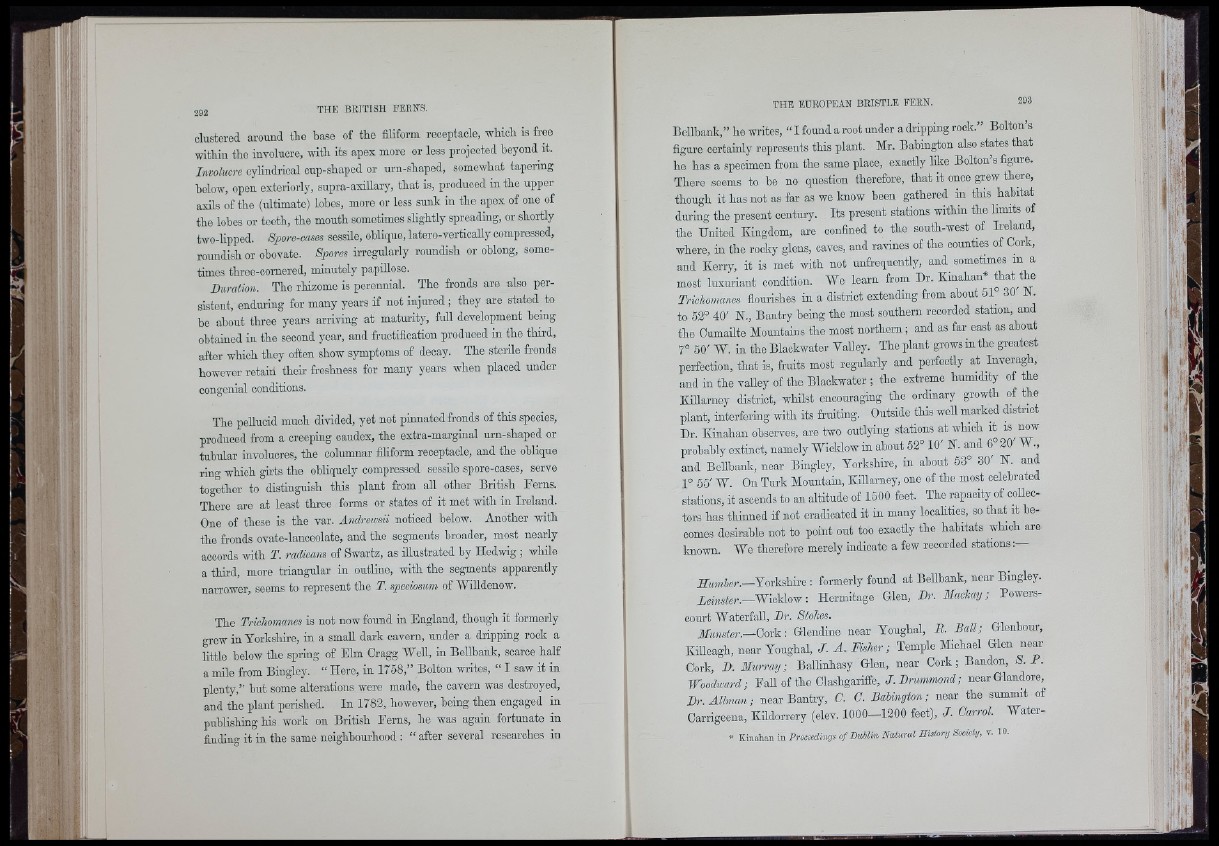
292 THE BRITISH FERNS,
clustered around tee base of tee filiform receptacle, whioh is free
within the involucre, with its apex more or less projected beyond it.
Involucre cylindrical cup-shaped or urn-shaped, somewhat tapering
below, open exteriorly, supra-axillary, that is, produced in tee upper
axils of tho (ultimate) lohes, moro or less sunk in tee apex of one of
tee lobes or teeth, tee mouth sometimes shghtly spreading, or shortly
two-lipped. Spore-cases sessile, oblique, latero-vertioally compressed,
roundish or obovate. Spores irregularly roundish or oblong, sometimes
threo-oornored, minutely papillose.
Buration. The rhizome is perennial. The fronds are also persistent,
endming for many years if not injured ; they are stated to
be about three years arriving at maturity, full development hemg
obtained in the second year, and fruotifioation produced in the third,
after which they often show symptoms of decay. The sterile fronds
however retain their freshness for many years when placed under
congenial conditions.
The peUuoid much divided, yet not pinnated fronds of this species,
produced from a creeping caudex, tee extra-marginal m-n-shaped or
tubular involucres, tee columnar filiform receptacle, and the oblique
ring which girts the obliquely compressed sessile spore-cases, serve
together to distinguish this plant from all other British Ferns.
There are at least throe forms or states of it met with in Ireland.
One of these is tee var. Andrewsii noticed helow. Another with
the fronds ovate-lanoeolate, and the segments broader, most nearly
accords with T. radicans of Swartz, as illustrated by Hedwig ; while
a third, more triangular in outline, with the segments apparently
narrower, seems to represent the T. speciosum of Willdenow.
The Trichomanes is not now found in England, though it formerly
grew in Yorkshfre, in a small dark cavern, under a dripping rock a
Httle helow the spring of Elm Cragg Well, in Bellbank, scarce half
a müe from Bingley. “ Here, in 1758,” Bolton writes, “ I saw it in
plenty,” hut some alterations were made, the cavern was destroyed,
and tee plant perished. In 1782, however, being then engaged in
publishing his work on British Ferns, he was again fortunate in
finding it in the same neighbourhood ; “ after several researches iu
THE EUROPEAN BRISTLE FERN. 293
Bellbank,” he writes, “ I found a root under a dripping rook.” Bolton’s
figure certainly represents this plant. Mr. Bahington also states teat
he has a specimen from the same place, exactly Hke Bolton’s figure.
There seems to be no question therefore, that it once grew there,
though it has not as far as we know been gathered in this habitat
during the present century. Its present stations within the limits of
the United Kingdom, are confined to the south-west M Ireland,
where, in tee rooky glens, caves, and ravines of the counties of Cork,
and Kerry, it is met with not unfrequently, and sometimes in a
most luxuriant condition. Wo learn from Dr. Kinahan* &at tee
Trichomanes flourishes in a district extending from about 51° 30 N.
to 52° 40' N., Bantry being tee most southern recorded station, and
tee Cumafite Mountains tee most northern; and as far east as about
7° 50' W. in the Blackwater YaUey. Tho plant grows in tee greatest
perfection, that is, fruits most regularly aud perfectly at Inveragh,
and in tee valley of tho Blackwater ; the extreme humidity of tee
Killarney district, whilst encouraging the ordinary growth of the
plant, interfering with its fruiting. Outside this weU marked district
Dr. Kinahan observes, are two outlying stations at which it is^now
probably extinct, namely Wioldow in about 52° 10' H. and 6° 20 W.,
and Bellbank, near Bingley, Yorkshire, in about 53° 30' N. and
1° 55' W. On Turk Mountain, Killarney, one of tee most celebrated
stations, it ascends to an altitude of 1500 feot. The rapacity of collectors
has thinned if not eradicated it in many looaHties, so that it becomes
desirable not to point out too exactly the habitats which are
known. We therefore merely indicate a few recorded stations
ITimiher.—YorkArae: formerly found at Bellbank, near Bingley.
icirasfer.—Wicklow: Hermitage Glen, Br. Mackay; Powerscourt
Waterfall, Dr. Btohes.
Munster.—Cork: Glendine near Youghal, R. Ball; Glenbour,
Killeagh, near Youghal, J. A. Fisher; Temple Michael Glen near
Cork, B. Murray; Ballinhasy Glen, near Cork; Bandon, S. P.
Woodward; F a U of the Clashgariffe, J. Dnmmowrf; near Glandore,^
Br. Allman; near Bantry, C. C. Bahington; near tee summit of
Carrigeena, Kildorrery (elev. 1000—1200 feet), J. Carrol. Water-
* Kinahan in Proceedings o f Dublin N a tu ra l Ilisfory Society, v. 10.
i!T ;
c d ;!
fa
i"i
<. A
li
{ :
i'-
m
1 1
il-'